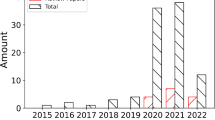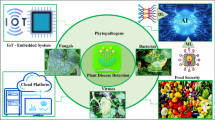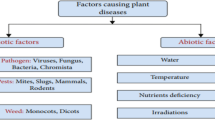Abstract
Coffee leaf rust (CLR) caused by the fungus Hemileia vastarix is a devastating disease in almost all coffee producing countries and remote sensing approaches have the potential to monitor the disease. This study evaluated the potential of Sentinel-2 band settings for discriminating CLR infection levels at leaf levels. Field spectra were resampled to the band settings of the Sentinel-2, and evaluated using the random forest (RF) and partial least squares discriminant analysis (PLS-DA) algorithms with and without variable optimization. Using all variables, Sentinel-2 Multispectral Imager (MSI)-derived vegetation indices achieved higher overall accuracy of 76.2% when compared to 69.8% obtained using raw spectral bands. Using the RF out-of-bag (OOB) scores, 4 spectral bands and 7 vegetation indices were identified as important variables in CLR discrimination. Using the PLS-DA Variable Importance in Projection (VIP) score, 3 Sentinel-2 spectral bands (B4, B6 and B5) and 5 vegetation indices were found to be important variables. Use of the identified variables improved the CLR discrimination accuracies to 79.4 and 82.5% for spectral bands and indices respectively when discriminated with the RF. Discrimination accuracy slightly increased through variable optimization for PLS-DA using spectral bands (63.5%) and vegetation indices (71.4%). Overall, this study showed the potential of the Sentinel 2 MSI band settings for CLR discrimination as part of crop condition assessment. Nevertheless further studies are required under field conditions.




Similar content being viewed by others
References
Avelino, J., Romero-Gurdián, A., Cruz-Cuellar, H. F., & Declerck, F. A. (2012). Landscape context and scale differentially impact coffee leaf rust, coffee berry borer, and coffee root-knot nematodes. Ecological Applications, 22(2), 584–596.
Avelino, J., Willocquet, L., & Savary, S. (2004). Effects of crop management patterns on coffee rust epidemics. Plant Pathology, 53(5), 541–547.
Baker, P., Bentley, J., Charveriat, C., Dugne, H., Leftoy, T., & Munyua, H. (2001). The Coffee Smallholder. In P. Baker (Ed.), Coffee Futures: A source book of some critical issues confronting the coffee industries. Chinchina: Cabi-Federacafe-USDA-ICO.
Barbedo, J. G. A. (2013). Digital image processing techniques for detecting, quantifying and classifying plant diseases. Spinger Plus, 2(660), 1–12.
Baret, F., & Buis, S. (2008). Estimating canopy characteristics from remote sensing observations: Review of methods and associated problems. In S. Liang (Ed.), Advances in land remote sensing: System, modeling, inversion and application (pp. 173–201). Amsterdam, The Netherlands: Springer.
Baret, F., & Guyot, G. (1991). Potentials and limits of vegetation indices for LAI and APAR assessment. Remote Sensing of Environment, 35, 161–173.
Barnes, E. M., Clarke, T. R., Richards, S. E., Colaizzi, P. D., Haberland, J., Kostrzewski, M., et al. (2000). Coincident detection of crop water stress, nitrogen status and canopy density using ground based multispectral data. In: P. C. Robert, R. H. Rust, W. E. Larson (Eds.) Proceedings of the 5th international conference on precision agriculture (pp 16–19). Madison, USA: American Society of Agronomy
Belan, L. L., Pozza, E. A., de Oliveira Freitas, M. L., Pozza, A. A. A., de Abreu, M. S., & Alves, E. (2015). Nutrients distribution in diseased coffee leaf tissue. Australasian Plant Pathology, 44(1), 105–111.
Breiman, L. (2001). Random forests. Machine Learning, 45(1), 5–32.
Breiman, L., & Cutler, A. (2007). Random forests-classification description. Berkeley, USA: Department of Statistics.
Brown, H. B. (2008). Smallholder coffee production in Zimbabwe. Harare, Zimbabwe: CRS Press.
Brown, J. K. M., & Hovmøller, M. S. (2002). Aerial dispersal of pathogens on the global and continental scales and its impact on plant disease. Science, 297, 537–541.
Cao, K.-A. L., Gonzalez, I., & Dejean, S. (2015). Package ‘mixOmics’. Retrieved 1 December, 2016 from http://www.mixOmics.org.
Carter, G. A., & Knapp, A. K. (2001). Leaf optical properties in higher plants: linking spectral characteristics to stress and chlorophyll concentration. American Journal of Botany, 88(4), 677–684.
Chemura, A., Kutywayo, D., Chidoko, P., & Mahoya, C. (2015). Bioclimatic modelling of current and projected climatic suitability of coffee (Coffea arabica) production in Zimbabwe. Regional Environmental Change, 16(2), 473–485.
Chemura, A. & Mutanga, O. (2016). Developing detailed age-specific thematic maps for coffee (Coffea arabica L.) in heterogeneous agricultural landscapes using random forests applied on Landsat 8 multispectral sensor. Geocarto International, 1–18 (inpress).
Clevers, J. G. P. W., & Gitelson, A. A. (2013). Remote estimation of crop and grass chlorophyll and nitrogen content using red-edge bands on Sentinel-2 and -3. International Journal of Applied Earth Observation and Geoinformation, 23, 344–351.
Coops, N., Stanford, M., Old, K., Dudzinski, M., Culvenor, D., & Stone, C. (2003). Assessment of Dothistroma needle blight of Pinus radiata using airborne hyperspectral imagery. Phytopathology, 93(12), 1524–1532.
Cressey, D. (2013). Coffee rust regains foothold. Nature, 493, 587.
D’Odorico, P., Gonsamo, A., Damm, A., & Schaepman, M. E. (2013). Experimental evaluation of Sentinel-2 spectral response functions for NDVI time-series continuity. IEEE Transactions of GeoScience & Remote Sensing, 51(3), 1336–1348.
Dangwal, N., Patel, N., Kumari, M., & Saha, S. (2016). Monitoring of water stress in wheat using multispectral indices derived from Landsat-TM. Geocarto International, 31(6), 682–693.
de Almeida, M. R., Correa, D. N., Rocha, W. F. C., Scafi, F. J. O., & Poppi, R. J. (2013). Discrimination between authentic and counterfeit banknotes using Raman spectroscopy and PLS-DA with uncertainty estimation. Microchemical Journal, 109, 170–177.
Devadas, R., Simpfendorfer, S., Backhouse, D., & Lamb, D. W. (2014). Effect of stripe rust on the yield response of wheat to nitrogen. The Crop Journal, 2(4), 201–206.
Dinesh, K. P., Shivanna, P., & Santa Ram, A. (2011). Identification of RAPD (Random Amplified Polymorphic DNA) markers for Ethiopian wild Coffea arabica L genetic resources in the tropics. Research: plant Genomics, 2(11), 1–7.
Dube, T., & Mutanga, O. (2015). Evaluating the utility of the medium-spatial resolution Landsat 8 multispectral sensor in quantifying aboveground biomass in uMgeni catchment, South Africa. ISPRS Journal of Photogrammetry and Remote Sensing, 101, 36–46.
Eitel, J. U. H., Gessler, P. E., Smith, A. M. S., & Robberecht, R. (2006). Suitability of existing and novel spectral indices to remotely detect water stress in Populus spp. Forest Ecology and Management, 229(1–3), 170–182.
Eitel, J. U. H., Vierling, L. A., Litvak, M. E., Long, D. S., Schulthess, U., Ager, A. A., et al. (2011). Broadband, red-edge information from satellites improves early stress detection in a New Mexico conifer woodland. Remote Sensing of Environment, 115(12), 3640–3646.
Feng, W., Shen, W., He, L., Duan, J., Guo, B., Li, Y., et al. (2016). Improved remote sensing detection of wheat powdery mildew using dual-green vegetation indices. Precision Agriculture, 17(5), 608–627.
Foody, G. M. (2004). Thematic map comparison: Evaluating the statistical significance of differences in classification accuracy. Photogrammetric Engineering & Remote Sensing, 70(5), 627–633.
Frampton, W. J., Dash, J., Watmough, G., & Milton, E. J. (2013). Evaluating the capabilities of Sentinel-2 for quantitative estimation of biophysical variables in vegetation. ISPRS Journal of Photogrammetry and Remote Sensing, 82, 83–92.
Ghimire, B., Rogan, J., Galiano, V. R., Panday, P., & Neeti, N. (2012). An evaluation of bagging, boosting, and random forests for land-cover classification in Cape Cod, Massachusetts`, USA. GIScience & Remote Sensing, 49(5), 623–643.
Ghini, R., Bettiol, W., & Hamada, E. (2011). Diseases in tropical and plantation crops as affected by climate change: Current knowledge and perspectives. Plant Pathology, 60, 122–132.
Gislason, P. O., Benediktsson, J. A., & Sveinsson, J. R. (2004). Random forest classification of multisource remote sensing and geographic data. In: Geoscience and remote sensing symposium, 2004 (IGARSS’04) (Vol 2, pp. 1049–1052). Piscataway: IEEE International
Gitelson, A. A., Kaufman, Y. J., & Merzlyak, M. N. (1996). Use of a green channel in remote sensing of global vegetation from EOS-MODIS. Remote Sensing of Environment, 58, 289–298.
Gitelson, A. A., & Merzlyak, M. N. (1994). Quantitative estimation of chlorophyll-a using reflectance spectra: Experiments with autumn chestnut and maple leaves. Journal of Photochemistry and Photobiology B: Biology, 22(3), 247–252.
Gitelson, A. A., Viña, A., Ciganda, V., Rundquist, D. C., & Arkebauer, T. J. (2005). Remote estimation of canopy chlorophyll content in crops. Geophysical Research Letters, 32, L08403.
Glenn, E. P., Huete, A. R., Nagler, P. L., & Nelson, S. G. (2008). Relationship between remotely-sensed vegetation indices, canopy attributes and plant physiological processes: What vegetation indices can and cannot tell us about the landscape. Sensors, 8(4), 2136–2160.
Gresser, C., & Tickell, S. (2002). Mugged: Poverty in your coffee cup. Boston, USA: Oxfam.
Haddad, F., Maffia, L. A., Mizubuti, E. S., & Teixeira, H. (2009). Biological control of coffee rust by antagonistic bacteria under field conditions in Brazil. Biological Control, 49(2), 114–119.
Hansen, M. C., & Loveland, T. R. (2012). A review of large area monitoring of land cover change using Landsat data. Remote Sensing of Environment, 122, 66–74.
Hedley, J., Roelfsema, C., Koetz, B., & Phinn, S. (2012). Capability of the Sentinel 2 mission for tropical coral reef mapping and coral bleaching detection. Remote Sensing of Environment, 120, 145–155.
Hill, M. J. (2013). Vegetation index suites as indicators of vegetation state in grassland and savanna: An analysis with simulated Sentinel 2 data for a North American transect. Remote Sensing of Environment, 137, 94–111.
Honorato Júnior, J., Zambolim, L., Aucique-Pérez, C. E., Resende, R. S., & Rodrigues, F. A. (2015). Photosynthetic and antioxidative alterations in coffee leaves caused by epoxiconazole and pyraclostrobin sprays and Hemileia vastatrix infection. Pesticide Biochemistry and Physiology, 123, 31–39.
Huang, W., Lamb, D., Niu, Z., Zhang, Y., Liu, L., & Wang, J. (2007). Identification of yellow rust in wheat using in situ spectral reflectance measurements and airborne hyperspectral imaging. Precision Agriculture, 8(4–5), 187–197.
Kutywayo, D., Chemura, A., Kusena, W., Chidoko, P., & Mahoya, C. (2013). The impact of climate change on the potential distribution of agricultural pests: The case of the coffee white stem borer (Monochamus leuconotus P.) in Zimbabwe. PLOS ONE, 8(8), e73432.
Lanfredi, M., Coppola, R., Simoniello, T., Coluzzi, R., Imbrenda, V., & Macchiato, M. (2015). Early identification of land degradation hotspots in complex bio-geographic regions. Remote Sensing, 7(6), 8154–8179.
Laudien, R., Bareth, G., & Doluschitz, R. (2004). Comparison of remote sensing based analysis of crop diseases by using high resolution multispectral and hyperspectral data: Case study: Rhizoctonia solani in sugar beet. In: S.A. Brandt (Ed.) Proceedings of the 12th International Conference on Geoinformatics, Gävle (pp. 670-676). Sweden: Gävle University Press.
Lebedev, A., Westman, E., Van Westen, G., Kramberger, M., Lundervold, A., Aarsland, D., et al. (2014). Random Forest ensembles for detection and prediction of Alzheimer’s disease with a good between-cohort robustness. NeuroImage: Clinical, 6, 115–125.
Li, X.-L., Yi, S.-L., He, S.-L., Lv, Q., Xie, R.-J., Zheng, Y.-Q., et al. (2016). Identification of pummelo cultivars by using Vis/NIR spectra and pattern recognition methods. Precision Agriculture, 17(3), 365–374.
Liaw, A., Wiener, M., Breiman, L., & Cutler, A. (2009). Package “randomForest”. Retrieved 1 December, 2016 from https://cran.r-project.org/package=randomForest.
Logan, W. J. C., & Biscoe, J. (1987). Coffee handbook. Harare: Zimbabwe Coffee Growers’ Association.
Mahlein, A. K., Rumpf, T., Welke, P., Dehne, H.-W., Plümer, L., Steiner, U., et al. (2013). Development of spectral indices for detecting and identifying plant diseases. Remote Sensing of Environment, 128, 21–30.
Mutanga, O., Adam, E., & Cho, M. A. (2012). High density biomass estimation for wetland vegetation using WorldView-2 imagery and random forest regression algorithm. International Journal of Applied Earth Observation and Geoinformation, 18, 399–406.
Mutanga, O., & Skidmore, A. K. (2004). Narrow band vegetation indices overcome the saturation problem in biomass estimation. International Journal of Remote Sensing, 25(19), 3999–4014.
Mutanga, O., & Skidmore, A. K. (2007). Red edge shift and biochemical content in grass canopies. ISPRS Journal of Photogrammetry and Remote Sensing, 62(1), 34–42.
Nitze, I., Schulthess, U., & H., A. (2012). Comparison of machine learning algorithms random forest, artificial neural network and support vector machine to maximum likelihood for supervised crop type classification. In: R.Q. Feitosa, G.A.O.P. Costa, C. M. Almeida, L. M. G. Fonseca, H.J.H. Kux (Eds.) Proceedings of the 4th GEOBIA (pp. 35–40). Rio de Janeiro, Brazil: Brazilian National Institute for Space Research.
Pal, M. (2005). Random forest classifier for remote sensing classification. International Journal of Remote Sensing, 26(1), 217–222.
Pal, M., & Foody, G. M. (2010). Feature selection for classification of hyperspectral data by SVM. IEEE Transactions on Geoscience and Remote Sensing, 48(5), 2297–2307.
Prabhakar, M., Prasad, Y. G., Desai, S., Thirupathi, M., Gopika, K., Rao, G. R., et al. (2013). Hyperspectral remote sensing of yellow mosaic severity and associated pigment losses in Vigna mungo using multinomial logistic regression models. Crop Protection, 45, 132–140.
R Core Team. (2013). R: a language and environment for statistical computing. Vienna, Austria. Retrieved from 31 Novemer 2016 http://www.R-project.org/.
Rembold, F., Atzberger, C., Savin, I., & Rojas, O. (2013). Using low resolution satellite imagery for yield prediction and yield anomaly detection. Remote Sensing, 5, 1704–1733. doi:10.3390/rs5041704.
Rodriguez-Galiano, V., Ghimire, B., Rogan, J., Chica-Olmo, M., & Rigol-Sanchez, J. (2012). An assessment of the effectiveness of a random forest classifier for land-cover classification. ISPRS Journal of Photogrammetry and Remote Sensing, 67, 93–104.
Rogan, J., Franklin, J., Stow, D., Miller, J., Woodcock, C., & Roberts, D. (2008). Mapping land-cover modifications over large areas: a comparison of machine learning algorithms. Remote Sensing of Environment, 112(5), 2272–2283.
Rouse, J. W., Haas, R. H., Schell, J. A., & Deering, D. W. (1973). Monitoring vegetation systems in the Great Plains with ERTS. In: S.C. Freden, E.P. Mercanti, M.A. Becker (Eds.) Proceedings of the third earth resources technology satellite-1 symposium, Greenbelt, Maryland, USA (pp 309).
Rulinda, C. M., Dilo, A., Bijker, W., & Stein, A. (2012). Characterising and quantifying vegetative drought in East Africa using fuzzy modelling and NDVI data. Journal of Arid Environments, 78, 169–178.
Saeys, Y., Inza, I., & Larrañaga, P. (2007). A review of feature selection techniques in bioinformatics. Bioinformatics, 23(19), 2507–2517.
Sankaran, S., Mishra, A., Ehsani, R., & Davis, C. (2010). A review of advanced techniques for detecting plant diseases. Computers and Electronics in Agriculture, 72, 1–13.
Savitzky, A., & Golay, M. (1964). Smoothing and differentiation of data by simplified least square procedure. Analytical Chemistry, 36(8), 1627–1638.
Silva, M. C., Várzea, V., Guerra-Guimarães, L., Azinheira, H. G., Fernandez, D., Petitot, A.-S., et al. (2006). Coffee resistance to the main diseases: Leaf rust and coffee berry disease. Brazilian Journal of Plant Physiology, 18(1), 119–147.
Stone, C., Chisholm, L., & Coops, N. (2001). Spectral reflectance characteristics of eucalypt foliage damaged by insects. Australian Journal of Botany, 49(6), 687–698.
Suresh, N., Santa, R. A., & Shivanna, M. B. (2012). Coffee leaf rust(CLR) and disease triangle: A case study. International Journal of Food, Agriculture and Veterinary Sciences, 2(2), 50–55.
Ustin, S. L., Gitelson, A. A., Jacquemoud, S., Schaepman, M., Asner, G. P., Gamon, J. A., et al. (2009). Retrieval of foliar information about plant pigment systems from high resolution spectroscopy. Remote Sensing of Environment, 113, S67–S77.
Vincini, M., Amaducci, S., & Frazzi, E. (2014). Empirical estimation of leaf chlorophyll density in winter wheat canopies using Sentinel-2 spectral resolution. IEEE Transactions of GeoScience & Remote Sensing, 52(6), 3220–3235.
Wang, C., Fritschi, F. B., Stacey, G., & Yang, Z. W. (2011). Phenology-based assessment of perennial energy crops in North American tallgrass prairie. Annals of the Association of American Geographers, 101(4), 742–751.
Wang, Q., Tenhunen, J., Dinh, N. Q., Reichstein, M., Vesala, T., & Keronen, P. (2004). Similarities in ground- and satellite-based NDVI time series and their relationship to physiological activity of a scots pine forest in Finland. Remote Sensing of Environment, 93(1–2), 225–237.
Acknowledgements
We are grateful to Coffee Research Institute for providing facilities and staff to support this research. This research was also partly funded by International Foundation for Science (IFS) Grants D/5441.
Author information
Authors and Affiliations
Corresponding author
Rights and permissions
About this article
Cite this article
Chemura, A., Mutanga, O. & Dube, T. Separability of coffee leaf rust infection levels with machine learning methods at Sentinel-2 MSI spectral resolutions. Precision Agric 18, 859–881 (2017). https://doi.org/10.1007/s11119-016-9495-0
Published:
Issue Date:
DOI: https://doi.org/10.1007/s11119-016-9495-0




